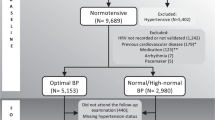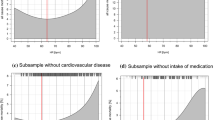Abstract
This study aims to examine the association between baseline level and change of autonomic nervous function with subsequent development of arterial stiffness. Autonomic nervous function was assessed in 4901 participants of the Whitehall II occupational cohort by heart rate variability (HRV) indices and resting heart rate (rHR) three times between 1997 and 2009, while arterial stiffness was assessed by carotid-femoral pulse wave velocity (PWV) measured twice between 2007 and 2013. First, individual HRV/rHR levels and annual changes were estimated. Then, we modelled the development of PWV by HRV/rHR using linear mixed effect models. First, we adjusted for sex and ethnicity (model 1), and then for socioeconomic and lifestyle factors, various clinical measurements, and medications (model 2). A decrease in HRV and unchanged rHR was associated with subsequent higher levels of PWV, but the effect of a change in HRV was less pronounced at higher ages. A typical individual aged 65 years with a SDNN level of 30 ms and a 2% annual decrease in SDNN had 1.32 (0.95; 1.69) higher PWV compared to one with the same age and SDNN level but with a 1% annual decrease in SDNN. Further adjustment had no major effect on the results. People who experience a steeper decline in autonomic nervous function have higher levels of arterial stiffness. The association was stronger in younger people.



Similar content being viewed by others
Data availability
Whitehall II data, protocols and other metadata are available to bona fide researchers for research purposes. Please refer to the Whitehall II data sharing policy at https://www.ucl.ac.uk/epidemiology-health-care/research/epidemiology-and-public-health/research/whitehall-ii/data-sharing.
Abbreviations
- CAN:
-
Cardiovascular autonomic neuropathy
- CVD:
-
Cardiovascular disease
- ECG:
-
Electrocardiogram
- HF power:
-
High-frequency power
- HRV:
-
Heart rate variability
- LF power:
-
Low-frequency power
- PWV:
-
Carotid-femoral pulse wave velocity
- rHR:
-
Resting heart rate
- RMSSD:
-
The root mean square of the sum of the squares of differences between consecutive normal-to-normal R-R intervals
- SDNN:
-
The standard deviation of normal-to-normal R-R intervals
References
Mendis S, Puska P, Norrving B, World Health Organization. Global atlas on cardiovascular disease prevention and control. Geneva: World Health Organization; 2011.
Ford ES. Trends in predicted 10-year risk of coronary heart disease and cardiovascular disease among US adults from 1999 to 2010. J Am Coll Cardiol. 2013;61(22):2249–52.
Levi-Marpillat N, Desamericq G, Akakpo S, Affes-Ayadi H, Tropeano A-I, Millasseau S, et al. Crucial importance of using a sliding calliper to measure distance for carotid-femoral pulse wave velocity assessment. J Hypertens. 2013;31(5):940–5.
Vlachopoulos C, Aznaouridis K, Stefanadis C. Prediction of cardiovascular events and all-cause mortality with arterial stiffness: a systematic review and meta-analysis. J Am Coll Cardiol. 2010;55(13):1318–27. https://doi.org/10.1016/j.jacc.2009.10.061.
Laurent S, Cockcroft J, Van Bortel L, Boutouyrie P, Giannattasio C, Hayoz D, et al. Expert consensus document on arterial stiffness: methodological issues and clinical applications. Eur Heart J. 2006;27(21):2588–605.
Mitchell GF, Hwang S-J, Vasan RS, Larson MG, Pencina MJ, Hamburg NM, et al. Arterial stiffness and cardiovascular events: the Framingham Heart Study. Circulation. 2010;121(4):505.
Mansour AS, Yannoutsos A, Majahalme N, Agnoletti D, Safar ME, Ouerdane S, et al. Aortic stiffness and cardiovascular risk in type 2 diabetes. J Hypertens. 2013;31(8):1584–92. https://doi.org/10.1097/HJH.0b013e3283613074.
Sethi S, Rivera O, Oliveros R, Chilton R. Aortic stiffness: pathophysiology, clinical implications, and approach to treatment. Integr Blood Press Control. 2014;7:29.
Cheung Y-F. Arterial stiffness in the young: assessment, determinants, and implications. Korean Circ J. 2010;40(4):153–62.
Shirwany NA, Zou MH. Arterial stiffness: a brief review. Acta Pharmacol Sin. 2010;31(10):1267–76. https://doi.org/10.1038/aps.2010.123.
Nilsson PM, Boutouyrie P, Laurent S. Vascular aging: a tale of EVA and ADAM in cardiovascular risk assessment and prevention. Hypertension. 2009;54(1):3–10.
Bruno RM, Ghiadoni L, Seravalle G, Dell’Oro R, Taddei S, Grassi G. Sympathetic regulation of vascular function in health and disease. Front Physiol. 2012;3:284.
Rajendra Acharya U, Paul Joseph K, Kannathal N, Lim CM, Suri JS. Heart rate variability: a review. Med Biol Eng Comput. 2006;44(12):1031–51. https://doi.org/10.1007/s11517-006-0119-0.
Camm AJ, Malik M, Bigger JT, Breithardt G, Cerutti S, Cohen R, et al. Heart rate variability: standards of measurement, physiological interpretation and clinical use. Task Force of the European Society of Cardiology and the North American Society of Pacing and Electrophysiology. Circulation. 1996;93:1043–65. https://doi.org/10.1161/01.CIR.93.5.1043.
Jensen-Urstad K, Reichard P, Jensen-Urstad M. Decreased heart rate variability in patients with type 1 diabetes mellitus is related to arterial wall stiffness. J Intern Med. 1999;245(1):57–61.
Chorepsima S, Eleftheriadou I, Tentolouris A, Moyssakis I, Protogerou A, Kokkinos A, et al. Pulse wave velocity and cardiac autonomic function in type 2 diabetes mellitus. BMC Endocr Disord. 2017;17(1):27. https://doi.org/10.1186/s12902-017-0178-2.
Chandra P, Sands RL, Gillespie BW, Levin NW, Kotanko P, Kiser M, et al. Relationship between heart rate variability and pulse wave velocity and their association with patient outcomes in chronic kidney disease. Clin Nephrol. 2014;81(1):9.
Tentolouris N, Liatis S, Moyssakis I, Tsapogas P, Psallas M, Diakoumopoulou E, et al. Aortic distensibility is reduced in subjects with type 2 diabetes and cardiac autonomic neuropathy. Eur J Clin Invest. 2003;33(12):1075–83.
Papanas N, Vinik AI, Ziegler D. Neuropathy in prediabetes: does the clock start ticking early? Nat Rev Endocrinol. 2011;7(11):682.
Saito I, Hitsumoto S, Maruyama K, Nishida W, Eguchi E, Kato T, et al. Heart rate variability, insulin resistance, and insulin sensitivity in Japanese adults: the Toon Health Study. J Epidemiol. 2015;25(9):583–91. https://doi.org/10.2188/jea.JE20140254.
Wulsin LR, Horn PS, Perry JL, Massaro JM, D’Agostino RB. Autonomic imbalance as a predictor of metabolic risks, cardiovascular disease, diabetes, and mortality. J Clin Endocrinol Metab. 2015;100(6):2443–8.
Marmot M, Brunner E. Cohort profile: the Whitehall II study. Int J Epidemio. 2005;34(2):251–6.
Hansen CS, Faerch K, Jorgensen ME, Malik M, Witte DR, Brunner EJ, et al. Heart rate, autonomic function, and future changes in glucose metabolism in individuals without diabetes: the Whitehall II cohort study. Diabetes Care. 2019;42(5):867–74. https://doi.org/10.2337/dc18-1838.
van Roon AM, Snieder H, Lefrandt JD, de Geus EJC, Riese H. Parsimonious correction of heart rate variability for its dependency on heart rate. Hypertension (Dallas, Tex: 1979). 2016;68(5):e63–5. https://doi.org/10.1161/HYPERTENSIONAHA.116.08053.
de Geus EJC, Gianaros PJ, Brindle RC, Jennings JR, Berntson GG. Should heart rate variability be “corrected” for heart rate? Biological, quantitative, and interpretive considerations. Psychophysiology. 2019;56(2):e13287. https://doi.org/10.1111/psyp.13287.
Johansen NB, Vistisen D, Brunner EJ, Tabák AG, Shipley MJ, Wilkinson IB, et al. Determinants of aortic stiffness: 16-year follow-up of the Whitehall II study. PloS one. 2012;7(5):e37165. https://doi.org/10.1371/journal.pone.0037165.
Gabir MM, Hanson RL, Dabelea D, Imperatore G, Roumain J, Bennett PH, et al. The 1997 American Diabetes Association and 1999 World Health Organization criteria for hyperglycemia in the diagnosis and prediction of diabetes. Diabetes Care. 2000;23(8):1108. https://doi.org/10.2337/diacare.23.8.1108.
World Health Organization. Definition and diagnosis of diabetes mellitus and intermediate hyperglycaemia: report of a WHO/IDF consultation. 2006. p. 50. https://apps.who.int/iris/handle/10665/43588.
Singer JD, Willett JB, Willett JB. Applied longitudinal data analysis: modeling change and event occurrence. Oxford university press; 2003.
Sacha J. Why should one normalize heart rate variability with respect to average heart rate. Front Physiol. 2013;4:306. https://doi.org/10.3389/fphys.2013.00306.
Monfredi O, Lyashkov AE, Johnsen AB, Inada S, Schneider H, Wang R, et al. Biophysical characterization of the underappreciated and important relationship between heart rate variability and heart rate. Hypertension. 2014;64(6):1334–43. https://doi.org/10.1161/hypertensionaha.114.03782.
Meyer C, Milat F, McGrath BP, Cameron J, Kotsopoulos D, Teede HJ. Vascular dysfunction and autonomic neuropathy in Type 2 diabetes. Diabet Med. 2004;21(7):746–51.
Liatis S, Alexiadou K, Tsiakou A, Makrilakis K, Katsilambros N, Tentolouris N. Cardiac Autonomic function correlates with arterial stiffness in the early stage of type 1 diabetes. Exp Diabetes Res. 2011;2011:957901. https://doi.org/10.1155/2011/957901.
Britton A, Shipley M, Malik M, Hnatkova K, Hemingway H, Marmot M. Changes in heart rate and heart rate variability over time in middle-aged men and women in the general population (from the Whitehall II Cohort Study). Am J Cardiol. 2007;100(3):524–7. https://doi.org/10.1016/j.amjcard.2007.03.056.
Kohn JC, Lampi MC, Reinhart-King CA. Age-related vascular stiffening: causes and consequences. Front Genet. 2015;6:112. https://doi.org/10.3389/fgene.2015.00112.
Tesauro M, Mauriello A, Rovella V, Annicchiarico-Petruzzelli M, Cardillo C, Melino G, et al. Arterial ageing: from endothelial dysfunction to vascular calcification. J Intern Med. 2017;281(5):471–82. https://doi.org/10.1111/joim.12605.
Mangoni AA, Mircoli L, Giannattasio C, Mancia G, Ferrari AU. Effect of sympathectomy on mechanical properties of common carotid and femoral arteries. Hypertension. 1997;30(5):1085–8. https://doi.org/10.1161/01.hyp.30.5.1085.
Mircoli L, Mangoni AA, Giannattasio C, Mancia G, Ferrari AU. Heart rate-dependent stiffening of large arteries in intact and sympathectomized rats. Hypertension. 1999;34(4 Pt 1):598–602. https://doi.org/10.1161/01.hyp.34.4.598.
Giannoglou GD, Chatzizisis YS, Zamboulis C, Parcharidis GE, Mikhailidis DP, Louridas GE. Elevated heart rate and atherosclerosis: an overview of the pathogenetic mechanisms. Int J Cardiol. 2008;126(3):302–12.
Park B-J, Lee H-R, Shim J-Y, Lee J-H, Jung D-H, Lee Y-J. Association between resting heart rate and arterial stiffness in Korean adults. Arch Cardiovasc Dis. 2010;103(4):246–52.
Acknowledgements
We thank all participating women and men in the Whitehall II Study, as well as all Whitehall II research scientists, study and data managers and clinical and administrative staff who make the study possible.
Funding
The UK Medical Research Council (K013351, R024227), British Heart Foundation and the US National Institutes of Health (R01HL36310, R01AG013196) have supported collection of data in the Whitehall II study. JFRS, DRW, AH and LB are employed at Steno Diabetes Center Aarhus, and CSH and DV are employed at Steno Diabetes Center Copenhagen. Both institutions are partly funded by a donation from the Novo Nordisk Foundation. The funders had no role in the design of the study. DRW and JRS are supported by EFSD/Sanofi European Diabetes Research Programme in diabetes associated with cardiovascular disease. AGT was supported by the UK Medical Research Council (S011676), NordForsk (the Nordic Research Programme on Health and Welfare, 75021), and by the Ministry of Innovation and Technology of Hungary from the National Research, Development and Innovation Fund (2021 Thematic Excellence Programme funding scheme, TKP2021-NKTA-47).
Author information
Authors and Affiliations
Contributions
Study concept and design: JRS, DRW, AH, MSC, LB, DV and CSH. Contributed the data: DRW and AGT. Planning the statistical analysis: JRS, DRW, AH, LB, MSC and DV. Conducted the statistical analysis: JRS. All authors contributed to, critically revised and approved the final version of the manuscript. JRS is the guarantor of this work and, as such, had full access to all the data in the study and takes responsibility for the integrity of the data and the accuracy of the data analysis.
Corresponding author
Ethics declarations
Ethics approval
The UK NHS Health Research Authority London-Harrow ethics committee approved the study, which was conducted in accordance with the Helsinki Declaration with written informed consent from all participants.
Conflict of interest
The authors declare no competing interests.
Additional information
Publisher's note
Springer Nature remains neutral with regard to jurisdictional claims in published maps and institutional affiliations.
Supplementary Information
Below is the link to the electronic supplementary material.
About this article
Cite this article
Schaarup, J.R., Christensen, M.S., Hulman, A. et al. Autonomic dysfunction is associated with the development of arterial stiffness: the Whitehall II cohort. GeroScience 45, 2443–2455 (2023). https://doi.org/10.1007/s11357-023-00762-0
Received:
Accepted:
Published:
Issue Date:
DOI: https://doi.org/10.1007/s11357-023-00762-0




